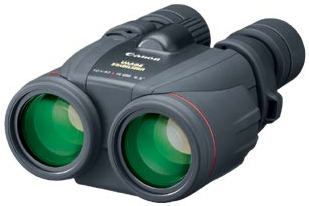
$220 SAVE $130 = 37.0% Western Digital 16.0TB Western Digital Ultrastar DC HC550 3.5-in… in Storage: Hard Drives
|

$500 SAVE $75 = 13.0% OWC 1.0TB OWC Atlas Pro SDXC V60 UHS-II Memory Card (2-Pack) in All Other Categories
|

|

|

|

|

|

|

|

|

|

|
Canon 10x42L IS WP Image Stabilized
The about $1000 Canon 10x42 L IS WP Image Stabilized Binocular (after rebate as this was written) affords a stabilize image at a magnification that is generally hand-holdable. However, movement (say on a boat) may make IS binoculars useful even at 10X—and 10X does get shaky even standing still.

The Canon IS line binoculars offer a key advantage over conventional binoculars: image stabilization for shaky hands, use on a moving boat or vehicle, etc.
This review is of the 10X42L IS WP model:
- WP = waterproof (but not specified as to submerions);
- IS = image stabilization;
- L is noted by a red ring on the binoculars themselves, denoting a particular attention to optical quality.
The 42mm objectives yield a very bright image, even approaching dusk.
Based on my experience with the Zeiss Victory 8X32 model with 16mm eye relief, I was concerned that that Canon 10X42L IS WP would also suffer from too little eye relief for ease of viewing. And indeed the eye relief does demand attention to eye placement to get a view that doesn’t black out (an issue with any binocular with 16mm eye relief).
The 16mm eye relief is mitigated by two factors: first, the 42mm objectives yield a 4.2mm exit pupil which mitigates the eye relief somewhat, and second, the image stabilization locks a stable image in place, which makes it a lot easier to keep the eyes where they need to be.
Canon’s specs say “prism binocular”, but the shape strongly suggests that these are a porro prism variant, which makes them bulkier and heavier than a roof prism design, but also yields better depth of view and slightly higher brightness than a roof prism design.
Image stabilization — a killer feature
Ordinary AA batteries (two) are used for the image stabilization feature.
That’s not just my opinion; I engaged two friends, both familiar with binoculars, to try my top pick Swarovsky EL 10X42 binoculars (without image stabilization) to the Canon 10X42L IS WP model.
Guess what? Both of them preferred the image stabilized view. No question about it. And considering that the Canon 10X42L IS WP costs about $1199 and the Swarovsky EL 10X42 costs about $2339, it’s an easy call. It was a clear-cut done-deal for these two.
One friend commented that he’d love to try the image stabilization feature on a boat.
Image stabilization in practice
Here’s the “problem”: first try the conventional Swarovsky EL 10X42 binoculars (which I preferred over Leica 8X42 and Zeiss 8X32 offerings).
Pick out a small bird, or text on a sign— anything with detail. Notice how long it takes to achieve crisp focus (try several targets, especially under dim lighting). Observe as much detail as you can.
Then try the same thing with the Canon image stabilized 10X42L IS.
With IS, your task suddenly becomes vastly easier: achieving sharp focus is faster because the image stays put. Observing detail is much easier, because the image stays puts. Without image stabilization, the image jiggles around, including (literally) with each heartbeat. With image stabilization all that nonsense disappears and your visual world quiets down, allowing concentration on the subject at hand.
This behavioral difference is so pronounced that you’ll question why anyone would want to work without image stabilization, but there are some downsides, read on for more.
Remember also that this is with 10X magnification; at 7X or 8X, the “jiggle” issue is notably less. But even when I braced my arms over my knees, the jiggles still persist at 10X, and image stabilization is still a big win.
Image stabilization is not perfect
Image stabilization was not perfect: while observing the moon, I noticed a slight “jitter” effect. Disabling image stabilization shows just how effective and useful it is when it’s enabled, but it does not render absolute stillness. Still, in daylight hours I didn’t notice this effect at all.
Optics
After comparing the Swarovsky EL 10X42 to the Canon 10X42L IS WP, I must say that the Canon optics are first rate. Canon’s experience with advanced ED glass and image stabilization clearly shows, such that any differences that might exist are more than outweighed by the value of image stabilization. I did feel that the Swarovsky EL 10X42 might be a little better in color or contrast, but I couldn’t nail down any obvious advantage, and with the rock-solid Canon image, the point is largely moot.
Flare control was outstanding, on par with the Swarovsky EL, even into the most difficult backlighting conditions. However, the lesser eye relief tends to generate more of what I’ll call a “flare effect”, which results when the eye is moved off-center even slightly, causing not a blackout, but a bright area over part of the image circle.
Ergonomics and design
A stable image is your #1 ergonomic issue. Image stabilization wins that battle, no contest. The 16mm eye relief is inferior to the 20mm eye relief of the Swarovsky EL 10X42, but (and it’s a big “but”), the image stabilization outweighs that consideration.
At first I disliked the bulky design of the 10X42L IS binocular. But after using it, I found that the design affords a more ergonomic grip for stability than the Swarovsky (or Leica or Zeiss) designs. A friend of mine came to the same conclusion. So all is not what is seems: while the design of the 10X42L IS looks ungainly, it actually works darn well for holding them while viewing!
No question the Swarovsky EL 10X42 is elegant and sleek looking, and lighter weight—beautiful. The Canon’s are pedestrian looking, not ugly, but not attractive either. But the goal is to see, presumably.
Unlike other brands, I found that keeping the eye-cups mostly retracted worked the best for me. Extending them fully was a non-starter, a black-out issue.
The lens caps over the front elements are poorly designed: they tend to fall off due to the minimal recessing of the front elements, and they cannot be affixed to the binocular itself.
Eyecups and diopter
The Canon 10X42L IS WP binocular does have one notable design flaw.
Adjusting the right eye-cup tends to also move the diopter setting. This is a serious nuisance that happens over and over; it adds an extra step of fixing the diopter adjustment every time the eye-cup is adjusted.
Lens coating and smudges
The lens coatings on the 10X42L IS WP smudge easily. Exacerbating this issue, the lenses are recessed only a token amount, which makes them prone to smudges and/or physical damage. I would have preferred 5mm or so more protection extending beyond the front elements. The front element is apparently a protective glass, so presumably repairing a scratch is not a huge expense.
However, the design allows the use of 52mm screw-in filters or lens hoods, so mounting a pair of multicoated filters solves the protection issue easily enough (not tested).
Conclusions and where to buy
At about $1199, the Canon 10X42L IS WP binoculars are a huge value: they offer top image quality and image stabilization. It’s just so much easier to focus upon and observe a small subject in detail (eg a bird) when the image is rock solid.
All is not perfect with the Canon 10X42L IS WP, but these factors are outweighed by the image stabilization feature and high quality optics.



















